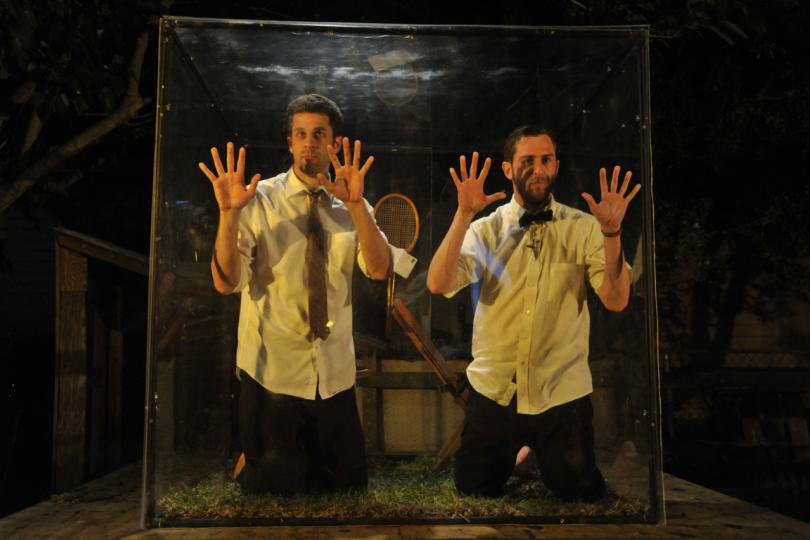Context and Scarcity

Editor's note: this is the first in a series of articles written by performing arts individuals who have moved from or to the Twin Cities exploring the similarities and differences of theatre communities and what can be learned by analyzing these comparisons.
I need to tell you the story of a door and its performance career in New Orleans. The door’s theatrical debut was June of 2016 in Jim Fitzmorris’s play The Killing of a Lesbian Bookie. Eight months later, when I walked into a rehearsal for my own play, Niagara Falls, I saw the door onstage again. It went from doing a naturalist drama with noir overtones to a decidedly experimental work with a strong comedic thread. In April, I saw Robert Askin’s Hand to God and there it was again. The door was so immersed in its new role that, at intermission, I needed to double check with a friend to make sure it was the same door. I barely recognized it. In May, I saw it in Conor McPherson’s The Birds. It’s a damn fine door, and I wonder what I’ll see it in next. I wonder if I’ll even recognize it. I know I’ll see it again because scarcity makes the New Orleans theater community self-supporting in a very concrete way.
As an artist who works in language, I get up, pour some coffee, and sit at my desk. I try to turn words into art. Then, with whatever brain I have left, I stumble into a classroom and show people how to do what I was just doing. From 1998 to 2012 my desk was in the Twin Cities; from 2012 until today it’s in New Orleans. The look of the experience is generally unchanged: big table in front of me, mug to the right, cat snoring to the left. However, actions never exist in isolation, and my context has shifted radically—one city is the land of Garrison Keillor, the other is the land of Tennessee Williams.
A city of excess / scarcity
In its public persona, New Orleans is a city of excess. In day-to-day life, New Orleans is a city of scarcity. Our scarcity produces a strong sense of community. Here one reaches out to friends, neighbors, and family members because poverty and a lack of societal resources negate other types of aid. Consequently, this is a place where a DIY approach to theatre (and just about everything else) is lauded. It’s a place always on the edge of economic, social, and environmental collapse. Because of the proximity to disintegration, there is a real, collective cooperation in our theatre community—behavior derived from social context. If this community turns into small artistic fiefdoms, it dies. If each theatre company only offers the other companies moral support, they all fail together. When I arrived in New Orleans, I promptly emailed the artistic director (or primary contact) of every local theatre company that popped up in a Google search. I heard back from most of them within 48 hours, all of them within a week. I did something similar in the Twin Cities not long after I finished graduate school at the turn of the millennium, and I still haven’t heard from most of them. As a new arrival in New Orleans, I was obviously somebody who needed support and, simultaneously, someone who could offer support. With the simple act of being physically here, I wasn’t a well-wisher, I was a participant. New Orleans welcomes all comers. It embraces my friends who swim in glitter and partial-nudity, and it embraces my nearly-monastic tendencies.
New Orleans has almost zero external resources for making theatre. Because Louisiana is one of the red-est of red states, New Orleans becomes little more than the best beach on Lord of the Flies Island. While St. Paul often operates as a cultural microcosm for the rest of Minnesota, much of Louisiana actively despises New Orleans. There is a cadre of Southerners who sincerely believe Hurricane Katrina was god’s punishment. Really. In fact, when massive flooding happened in Baton Rouge last year, one of the religious leaders who claimed Katrina was divine punishment lost his home. A local news anchor calmly pointed out the fact of this loss, said nothing of its subtext nor its irony, and moved on. This land is an island that fears the human condition and a beach that embraces it. St. Paul is enough like Pipestone or Grand Marais that I can be in either of those towns and generally understand the cultures of the other two. When I step outside of New Orleans I’m in a different world entirely. Actually, I can’t just step outside of the city because it’s surrounded by water. To leave, I must cross a bridge or take a ferry. St. Paul sits on a high bluff overlooking the Mississippi River; New Orleans is a bowl dipping below sea level with the Mississippi forming its southern meniscus.
I was not expecting so much culture shock when I moved from one city to another within the same nation. While standing between the grave of the semi-mythical witch Marie Laveau and the stone statue that cradles Peter Fonda in Easy Rider, a tour guide suggested it was better to understand New Orleans as the Northernmost city in the Caribbean than as a city in the American south. Compared to Port-au-Prince, we’re pretty functional. Unfortunately, state-level political agendas push us towards 3rd world problems. This spring, Louisiana was ranked 50th in overall quality of life by the “Best States” list from US News and World Report. Politico Magazine ranked us 51st because they included Washington D.C. US News ranked Minnesota 3rd, Politico ranked it 2nd. To illustrate such abstract rankings, in 2015 a handful of Mylar balloons floated away from a child’s party and knocked out potable water for hundreds of thousands of people for several days. Our basic life-support systems aren’t balloon proof. When it’s hard to get state support for drinking water, getting support for the arts is a tough sell. This contextual shift trained me to pay extra attention to a well-made door.
As our extremist political ideology gains power nationally, our problems will become your problems, in the same way that Louisiana’s problems are New Orleans’s problems. Without serious state support for the arts, it’s natural to turn to private donations. However, in New Orleans, much of our private funding is Hoovered up by the titanic force of Mardi Gras. When donated to a Mardi Gras krew, the kind of money that gets someone mentioned in a theatre program and invited to an appreciation dinner in the Twin Cities (or in New Orleans for that matter) gets that person up on a parade float with thousands, sometimes hundreds of thousands, of people cheering and shouting for beads. Three hundred thousand people go to the Endymion Parade. It takes hours for one float to go from the beginning to the end, and the parade culminates in a giant party inside the Superdome. While the parade is only for a day, it offers rock star level adulation. No theatre company in America can treat their patrons to that level of attention.
Community
The door I keep seeing on stage is a physical thing. It’s performance hinges on context. Because scarcity is the context in New Orleans, community becomes a phenomenon that can’t stop at the conceptual. If somebody has a door they’re not using, odds are somebody else needs it. While perpetual scarcity can make much of our theatrical life feel like a scavenger hunt, physical support means that more of our limited capital can be invested in things that aren’t easily share-able. When several small companies realized they needed storage space, they went in on a locker. It’s easy to see a door auditioning in the back of a shared locker and know it’s perfect for an upcoming show, and it’s obviously not cast in anything at the moment, or it wouldn’t be in the locker in the first place.
Recently, in New Orleans, I caught You Don’t Know the Half of It, a combination theatre/improv event that is perpetually delightful. While the door wasn’t in the show, one of the improvisors was the co-Artistic Director for Goat in the Road theatre company. One of the actors was the Artistic Director of The NOLA Project. One company makes experimental, collectively-generated performance; the other produces mainstream, contemporary work. Both companies have enough clout that their works have appeared on the cover of American Theatre Magazine. The stage they were on belonged to Le Petit Theatre, one of the oldest in the country. I saw a lot of theatre in the Twin Cities when I lived there, but I can’t recall seeing the AD of even one company working for another company, much less a smaller one. Nor all of them on the stage of a fourth company. That night, two or three more theatre companies had core members in the audience. Moreover, I know both of those ADs, and many of their company members, saw that door on stage at least twice. This is a community that supports each other with their bodies.
Like any community, the New Orleans theatre community has nuances, rivalries, and struggles beyond what I can explore in this essay; however, it’s beginning to take on a struggle that the Twin Cities community is well-positioned to address: shared audience. Audience is a unique kind of scarcity that is especially noticeable when ticket sales become the primary revenue generator for an organization. There are a particularly-finite number of theatre goers in New Orleans, which is becoming more obvious as the performance community expands. Growth is a new phenomenon here and theatres struggle with a fixed, core audience and an increasing volume of shows. While many people work to grow the audience of consistent theatre goers in the long term, right now audiences are an established cadre. Our local companies are learning to coordinate in a way that the Twin Cities are well-situated to do. Publications like this one are an obvious resource. Similarly, if a city can sustain unified auditions, it can have an AD meet-up for season planning. Last fall, here in New Orleans, multiple shows opened on the same weekend. Not surprisingly, they all struggled with ticket sales. A year or two before, three companies did the same play in the same season. Coordination minimizes the problem of a very finite audience, and better coordination would have put a lot more buts in seats for each company.
Good coordination means people making work with Company A can go out to see a show by Company B because schedules can have minimal overlap. While NOLA hasn’t gotten a plan as ambitious as getting all the ADs together to chat about their seasons, some in our city are starting to see the need for it, and to understand its intrinsic value. A giant wall calendar (or its electronic equivalent) that lets everyone chart and display their seasons allows for the fine tuning of schedules to minimize competition and maximize availability. Lots of opportunities spring from this physical support: A night without rehearsal is a great way to let a cast see a show with a similar run. Making sure two companies with similar aesthetic don’t have overlapping runs can increase houses for both. It also creates a chance for effective cross promotion, e.g. a collective ad for all the Shakespeare shows in a season, or a shrewd “if you liked X, you’ll love Y.” The Southern Theater’s ARTshare Program demonstrates success with a similar model, and the aforementioned endeavors are its natural ally. We’re talking about such organization down here where the lack of resources makes it a necessity, but the Twin Cities is situated to actually manifest it.
As forced scarcity grows in Minnesota it’s wise to look at the folks who are surviving, thriving, in scarcity. When money is reduced, the loss of that resource can be mitigated with concrete support and overtly-supportive communication. In the Twin Cities the necessary tools seem to be in the box, it’s just a matter of mastering them. After all, if we make good doors, lots of patrons will be happy to walk through them.




